 An
article in the January 1993 National Geographic boldly proclaimed:
“No human being has ever seen a live dinosaur” (“Age of the Dinosaurs,”
1993, 183[1]:142). The evidence, however, reveals an entirely different
story. Consider the following:
An
article in the January 1993 National Geographic boldly proclaimed:
“No human being has ever seen a live dinosaur” (“Age of the Dinosaurs,”
1993, 183[1]:142). The evidence, however, reveals an entirely different
story. Consider the following:
The Doheny Expedition
In the late 1800s, evolutionist Samuel Hubbard, honorary curator of archaeology at the Oakland, California, Museum of Natural History, was excavating ancient Indian dwellings in the Hava Supai Canyon in Arizona. On the walls of the canyon where the Indians’ ancestors once lived, Dr. Hubbard found elegant drawings of an elephant, an ibex, a dinosaur, and other animals. He stated concerning the dinosaur drawing: “Taken all in all, the proportions are good.” He further suggested that the huge reptile is “depicted in the attitude in which man would be most likely to see it—reared on its hind legs, balancing with the long tail, either feeding or in fighting position, possibly defending itself against a party of men” (as quoted in Verrill, 1954, pp. 155ff.). Dr. Hubbard also noted:
The fact that some prehistoric man made a pictograph of a dinosaur on the walls of this canyon upsets completely all of our theories regarding the antiquity of man.... The fact that the animal is upright and balanced on its tail would seem to indicate that the prehistoric artist must have seen it alive (1925, pp. 5,7, emp. in orig.).
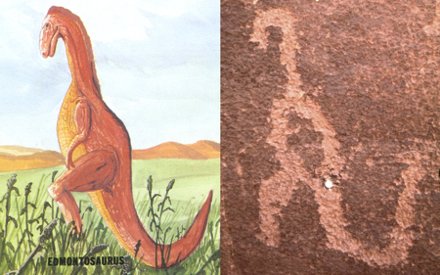 |
| Left: Edmontosaurus
(courtesy of Paul S. Taylor, Eden Communications). Right: Petroglyph discovered by Dr. Samuel Hubbard in Havai Supai Canyon (courtesy of www.bible.ca). |
Nearby, Dr. Hubbard and his team of archaeologists discovered dinosaur tracks preserved in strata identified as Triassic—alleged by evolutionists to be more than 165 million years old. Question: How could Indians have known how to draw such a perfect picture of an animal (the dinosaur) that they never had seen (or had described to them by someone who had seen it)?
According to the belief commonly held by evolutionists, no advanced mammals were present during the “age of the dinosaurs.” Artists’ reconstructions generally show the huge reptiles living in swamps, surrounded only by other species of dinosaurs. The late evolutionary paleontologist George Gaylord Simpson suggested that the only mammals that had evolved up to that point in time (even at the very end of the Cretaceous period) were supposedly “small, mostly about mouse-sized, and rare” (Simpson, et al., 1957, p. 797). In his book, Wonderful Life: The Burgess Shale and the Nature of History, Stephen J. Gould addressed the same issue when he wrote:
Mammals evolved at the end of the Triassic, at the same time as dinosaurs, or just a tad later. Mammals spent their first hundred million years—two-thirds of their total history—as small creatures living in the nooks and crannies of a dinosaur’s world. Their sixty million years of success following the demise of the dinosaurs has been something of an afterthought (1989, p. 318).
It thus is completely unthinkable, in evolutionary terms, that dinosaurs and advanced mammals (like elephants or giraffes) could have co-existed. Again, however, Dr. Hubbard’s discoveries have “thrown a monkey wrench” into the evolutionary timescale.
However, a discovery reported in the January 13, 2005, issue of Nature challenged everything evolutionists have ever maintained regarding dinosaurs and mammals. The Associated Press reported: “Villagers digging in China’s rich fossil beds have uncovered the preserved remains of a tiny dinosaur in the belly of a mammal, a startling discovery for scientists who have long believed early mammals couldn’t possibly attack and eat a dinosaur” (Verrengia, 2005). Not only do we now have additional proof of mammals coexisting with dinosaurs, but we also have scientific evidence of a large mammal eating a dinosaur! The authors discovered the fossil remains of two different mammals. One was 50% larger than previous mammal fossils that were considered to be living with the dinosaurs, and was named Repenomamus giganticus. The other, Repenomamus robustus was fully intact—and had a dinosaur in its stomach. Yaoming Hu and his colleagues noted:
During preparation of the specimen a patch of small bones was revealed within the ribcage, on the ventral sides of the posterior left thoracic ribs and vertebrae, where the stomach is positioned in extant mammals. Unduplicated dentition [teeth—BH], limb bones and phalanges [bones of the toes or “fingers”—] in the patch confirm that these bones belong to a juvenile individual of Psittacosaurus, an herbivorous dinosaur that is common in Jehol Biota. The serrated teeth in the patched skeleton are typical of juvenile Psittacosaurus. The skull and most of the skeleton of the juvenile Psittacosaurus are broken, disarticulated and displaced, in contrast to the preservation of the R. robustus skeleton, which is essentially in its original anatomical relation. Although fragmentary, the bones of the Psittacosaurus are packed in a restricted area. These conditions indicate that the juvenile skeleton of Psittacosaurus is the remaining stomach contents of the mammal (Hu, et al., 2005, 433:151).
To complicate matters, researchers reported in the April 18, 2002 issue of Nature, one of the premier science journals in the world, that they now have determined that the “last common ancestor of extant primates” existed (as dated by evolutionary dating methods) 85 million years ago (Tavaré, et al., 2002). Since dinosaurs are supposed to have died out 65 million years ago, that means the primate would have lived with the dinosaurs for at least 20 million years. One of the co-authors of the Nature paper, Christophe Soligo of London’s Natural History Museum, stated in regard to the find: “What we demonstrate is that modern orders of mammals appeared well before dinosaurs disappeared...” (see “Primate Ancestor Lived with Dinos,” 2002). So much for the belief that mammals evolved “just a tad later” than the dinosaurs.
Ica Burial Stones
Javier Cabrera Darquea came into possession of his first burial stone (from the Ica section of the country of Peru) when he was given one as a paperweight for his birthday. Ironically, he could recall his own father also possessing similar oddly carved stones that his family found in their fields in the 1930s. Dr. Darquea sought out the origin of his unique gift, in an effort to amass a collection of these unique stones, and eventually assembled over 11,000 of them. The rocks turned out to be ancient burial stones that the Inca Indians placed with their dead. Almost one-third of the stones depicted specific types of dinosaurs (such as Triceratops and Stegosaurus) and various pterosaurs. The type of art form represented by these stones, and their location, dated them to the time of the Inca Culture, c. A.D. 500-1500. How could these ancient Indians have known the anatomy of these creatures if they never had witnessed them firsthand?
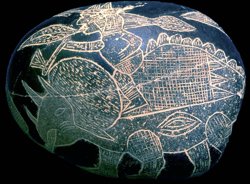 |
|
Image courtesy of www.bible.ca
|
Interestingly, several Diplodocus-like dinosaurs on the stones have what appear to be dermal frills—something never previously reported by scientists. In 1992, however, dermal frills were found during an examination of fossilized remains of sauropods. In an article titled “New Look for Sauropod Dinosaurs,” paleontologist Stephen Czerkas noted:
Recent discovery of fossilized sauropod (diplodocid) skin impressions reveals a significantly different appearance for these dinosaurs. The fossilized skin demonstrates that a median row of [dermal] spines was present.... Some are quite narrow, and others are broader and more conical (1992, 20:1068).
Also, the skin of many of the carved dinosaurs resembled bumpy rosettes. For many years, scientists pointed to this as proof that these stones were not scientifically accurate. However, more recent discoveries of fossilized dinosaur skin and embryos have silenced the critics. In more than one report, these bumpy rosettes have been identified and discussed. In fact, one of the discoveries comes from the same continent as the Ica burial stones. Luis Chiappe and colleagues discussed sauropod dinosaur embryos, noting:
The general skin pattern consists of round, non-overlapping, tubercle-like scales.... A rosette pattern of scales is present in PVPH-130 [designation for one of the specimens—BH/BT] (Chiappe, et al., 1998, 396:259).
Again, we must ask: How could the Incas have drawn such accurate pictures of dinosaurs if they never had seen the animals (or had them described by someone who had seen them)? [For a discussion of Dr. Darquea’s research, see Swift, 1997].
Natural Bridges National Monument Petroglyph
Natural Bridges National Monument is located in a desolate area in southeastern Utah. Visitors to this site will see where the White River has carved meandering paths through the sandstone rock. Three natural bridges have formed where these wandering streams have undercut the above rock formations: Sipapu Bridge (the second largest natural bridge in the world); Kachina Bridge; and Owachomo Bridge. It is at Kachina Bridge where an Indian petroglyph depicting a dinosaur was discovered. In fact, visitors to the site can see three or four drawings that appear to be dinosaur-like creatures. Francis Barnes, an evolutionist and widely recognized authority on rock art of the American Southwest, had this to say about this find just outside of Blanding, Utah:
There is a petroglyph in Natural Bridges National Monument that bears a startling resemblance to a dinosaur, specifically a Brontosaurus, with long tail and neck, small head and all. In the San Rafael Swell, there is a pictograph that looks very much like a pterosaur, a Cretaceous flying reptile. The artists who created this “pterosaur,” and the “dinosaur,” could of course, have been trying to portray some other real or imagined creatures. But what about other animals seen on rock art panels, such as “impalas,” “ostriches,” “mammoths” and others that either are long extinct in the western hemisphere or were never here at all? Such anomalous rock art figures can be explained away, but they still tend to cast doubt upon the admittedly flimsy relative-time age-dating schemes used by archaeologists (Barnes and Pendleton, 1979, pp. 201-202).
If National Geographic is correct in stating that “no human being has ever seen a live dinosaur,” then whence came the models for these petroglyphs?
The Acambaro Figurines
On a bright and sunny morning in July 1944, Waldemar Julsrud, a German merchant in Acambaro, Mexico, found himself riding on horseback on the lower slope of El Toro (The Bull) Mountain. From his elevated vantage point, Mr. Julsrud spotted some partially exposed, hewn stones and a ceramic object half buried in the dirt. After climbing off his horse, he dug the stones (and a few ceramic pieces) out of the ground. Being somewhat archaeologically astute, Julsrud immediately realized that these artifacts were unlike anything that he had ever seen. The objects he held in his hand seemed distinctively different than those from other known Indian cultures. He eventually worked out a deal with a local farmer to excavate these precious pieces.
Eventually, over 33,500 figurines and artifacts of ceramic and stone (including some in jade) were uncovered. A key feature of this discovery was the fact that many of the artifacts were highly detailed dinosaur figurines. Charles Hapgood, a professor of history and anthropology at Keene State College (of the University of New Hampshire), became interested in the figurines and decided to investigate firsthand. Initially, Hapgood was a self-confessed (but open-minded) skeptic. However, after witnessing the excavations (even going so far as to dictate specific locations for the workers doing the digging), and after examining the figurines personally, he became a believer. He made his first visit to Acambaro in 1955, returned on numerous occasions, and eventually authored a book about his eighteen years of research into the figurines (see Hapgood, 2000). Consider the following measures, enacted to establish the authenticity of the Acambaro collection:
When Teledynes Isotopes laboratories performed dating tests on the carbon deposited during firing on ceramic samples submitted by Hapgood, dates of up to 4530 B.C. obtained. Arthur M. Young, the inventor of the Bell Helicopter, who had sponsored Hapgood’s investigation along with [Erle Stanley] Gardner [author of the Perry Mason mysteries—BH/BT], submitted Julsrud artifact samples [i.e., the Acambaro figurines—BH/BT] to the University of Pennsylvania for dating. Radiocarbon dating performed by Dr. Froelich Rainey in the laboratories of the University indicated that this culture may have been developed between 6,400 and 3,500 years ago. Additional tests using thermoluminescence method of dating pottery were performed. They produced dates of up to 4,500 B.P. (Before Present), or 2500 B.C., which upset the professional archaeologists and set off within the scientific and museum world a controversy over the accuracy of thermoluminescence dating. Retesting was done, and it was announced that because of anomalous factors in the clays it was impossible to determine an accurate date (Hapgood, p. 17).
According to David Childress, who penned the foreword to Hapgood’s book, the most recent thermoluminescence testing done on Acambaro pottery fragments (taken by Bill Cote and John H. Tierney during the filming of the video, Jurassic Art, in the early 1990s) obtained results of 3,975±55 B.P. (Hapgood, p. 18). Consider also the fact that teeth from an extinct ice-age horse, the skeleton of a woolly mammoth, and a number of human skulls also were found at the same site as the ceramic artifacts. Hapgood noted: “I later took these teeth to Dr. George Gaylord Simpson, America’s leading paleontologist, at the Museum of Natural History. He identified them as the teeth of Equus conversidans owen, an extinct horse of the ice age” (p. 82). Thus, the collection had evidence of extinct animals, human skulls, and dinosaur carvings from the same culture of people. But how could this be?
In 1999, Dennis Swift (who also was personally acquainted with Javier Darquea of Peru) made a trip to view the figurines. After receiving permission from the local authorities, he began to unwrap the ceramic figures. Dr. Swift noted:
There was an absolutely astonishing moment of breathless magnitude as one object was unwrapped and there before us was an Iguanodon dinosaur figurine. [For documentation on the Iguanodon discovery to which Swift alluded, see The Dinosaur Encyclopedia (Michael Benton, 1992, New York: Simon & Schuster, p. 80).]
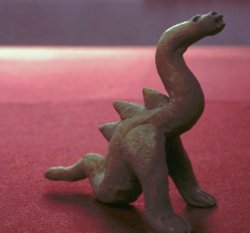 |
|
Image courtesy of www.bible.ca
|
Childress went on to note in an article titled “In Search of Sea Monsters”:
Adding to the mind-boggling aspects of this controversy is the fact that the Instituto Nacional de Antropologia e Historia through the late Director of Prehispanic Monuments, Dr. Eduardo Noguera, admitted “the apparent scientific legality with which these objects were found.” Despite evidence of their own eyes, however, officials declared that because of the objects’ “fantastic” nature, they had to have been a hoax! (no date).
This archaeological “hoax” presents insoluble problems for evolutionists. As Childress put it, “Most ‘respectable’ archaeologists will walk around the Acambaro mystery as if it were a land mine. The very existence of the figurines threatens the ivory tower of the current paradigm of history” (as quoted in Hapgood, 2000, p. 20).
Dinosaur Bones Only Thousands of Years Old?
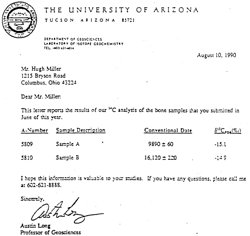 |
In 1990, samples of various dinosaur bones were submitted for Carbon-14 dating to the University of Arizona’s department of geosciences’ laboratory of isotope geochemistry. Bones from an Allosaurus and an Acrocanthosaurus were among those sent to the university’s testing facilities to undergo a “blind” dating procedure (which means that the technicians performing the tests did not know that the bones had come from dinosaurs). Not realizing that the samples were from dinosaurs prevented “evolutionary bias,” and helped ensure that the results were as accurate as possible (within the recognized assumptions and limits of the C-14 dating method). We have in our possession—on the official stationery of the University of Arizona—a copy of the test results for the Allosaurus bones (see reproduction at right, sample B). Amazingly, the oldest C-14 date assigned to those bones was a mere 16,120 years (and only 23,760 years for the Acrocanthosaurus fossils; see Dahmer, et al., 1990). Both dates are a far cry from the millions of years that evolutionists suggest should be assigned to dinosaur fossils.
The Monster of Troy
The February 26, 2000 issue of Science News contained an article that diligently attempted to defuse a potential bomb within the evolutionary camp (Hesman, 2000). Sitting inside the Boston Museum of Fine Arts is an ancient Greek vase. This vase is covered by a series of somewhat unusual paintings, including one that is bewildering to both archaeologists and evolutionists. The vase portrays a monster that possesses the head of a dinosaur. And, to make matters worse, the images on the vase depict men and dinosaurs as coexisting.
Known as the Hesione vase, this elegant potteryware was created around 550 B.C., and depicts the Greek hero Heracles rescuing Hesione from the monster of Troy. The tale of the monster was first told by Homer in the eighth century B.C. In this legend, a terrifying monster suddenly appeared on the Trojan coast after a flood, and began preying on the farmers in the neighborhood of Sigeum. The king’s daughter, Hesione, was sent to be offered as a sacrifice to the monster, but according to the legend, Heracles arrived in time to kill it. The painting on the vase shows Hesione and Heracles battling the monster, with Hesione tossing rocks at it, and Heracles shooting arrows. You can understand the obvious plight of evolutionists when confronted with such imagery. Thus, in an effort to “explain” this artwork in light of evolutionary timescales, the editors of Science News concluded that the paintings on this unusual vase simply prove that ancient people dug fossils, too. They believe that this painting was the end result of fossils—possibly of an extinct giraffe—that were dug up thousands of years ago. What’s that old saying? If it looks like a duck, walks like a duck, and quacks like a duck, it’s probably a—giraffe?
Human Footprints with Dinosaur Tracks?
Consider also that in 1983, researchers reported in the science and engineering news section of The Moscow News that they had discovered what appeared to be a human footprint in 150-million-year-old Jurassic rock, next to a giant, three-toed dinosaur footprint. The article stated:
This spring, an expedition from the Institute of Geology of the Turkmen SSR Academy of Sciences found over 1,500 tracks left by dinosaurs in the mountains in the southeast of the Republic [Turkmen Republic—BH/BT]. Impressions resembling in shape a human footprint were discovered next to the tracks of prehistoric animals (see “Tracking Dinosaurs,” 1983, 24:10).
Naturally, this report has received precious little attention, given the mindset of evolutionists.
Historical Records of Flying Reptiles
Additional evidence for the coexistence of humans and dinosaurs is derived from various ancient writings. For instance, the largest creature ever known to have soared in the skies above the Earth was a pterosaur identified as Quetzalcoatlus (KWET-zal-COAT-lus). The fossil bones of one of these flying reptiles were unearthed in 1972 at Big Bend National Park in Texas. This Quetzalcoatlus had a wingspan of 48 feet (which is longer than some small airplanes!). While these giant birds are not classified scientifically as dinosaurs (since they are not strictly land-dwelling creatures, as dinosaurs were, by definition), they often are lumped into a group of animals known as “dinosaur-like” creatures. Notice the following quotation taken from Herodotus, a Greek historian from the fifth century B.C., who wrote:
There is a place in Arabia...to which I went, on hearing of some winged serpents; and when I arrived there, I saw bones and spines of serpents, in such quantities as it would be impossible to describe. The form of the serpent is like that of a water-snake; but he has wings without feathers, and as like as possible to the wings of a bat (1850, pp. 75-76, emp. added).
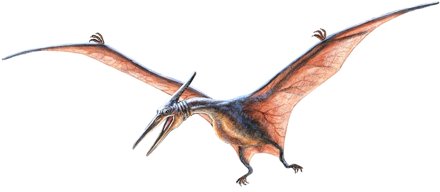 |
|
Pteranodon
|
Herodotus knew of flying reptiles, and recognized that these creatures were neither birds, mammals, nor insects—but reptiles with wings. Notice also what the Jewish historian Josephus wrote 2,000 years ago about Moses and his army having a difficult time passing through a particular region because of the presence of flying serpents.
When the ground was difficult to be passed over, because of the multitude of serpents (which it produces in vast numbers...some of which ascend out of the ground unseen, and also fly in the air, and do come upon men at unawares, and do them a mischief)....
[Moses] made baskets like unto arks, of sedge, and filled them with ibes [i.e., birds], and carried them along with them; which animal is the greatest enemy to serpents imaginable, for they fly from them when they come near them; and as they fly they are caught and devoured by them (n.d., 2:10:2, emp. added).
Although these two historians do not mention the extremely large flying reptiles, they do record that snake-like winged creatures, which could fly, did live in the distant past. These reports are consistent with findings that A.H. Verrill reported in 1954 in his book, Strange Prehistoric Animals and Their Stories.
Primitive man, finding a fossil pterodactyl, might assume that the skeleton was that of some strange winged monster which still existed. Being totally ignorant of fossils and geology, an Indian or any other savage or semi-savage human being would never suspect that the bones had been reserved in rock for millions of years. Neither would it be possible for such primitive men to reconstruct mentally the creature as they appeared in life.... It is of course, inconceivable that the Cocle potter had first-hand knowledge of a living pterodactyl, ancient as the pottery is; yet had he been as familiar with the flying monsters as he was with pelicans and jaguars, he could not have depicted them more strikingly and accurately. Not only do the drawings show beak-like jaws armed with sharp teeth, but in addition the wings with two curved claws are depicted. Included also are the short, pointed tail, the reptilian head crest or appendages, and the strong hind feet with five-clawed toes on each (1954, pp. 55,57-58).
Obviously, the scientific evidence for the coexistence of dinosaurs and man speaks loudly, and yet it continues to fall on deaf ears within the evolutionary community. That silence, however, does little to change the documented facts, as we now know them.
Contrary to popular opinion, dinosaurs do not present a problem for creationists. In fact, quite the opposite is true. It is evolutionists who have a problem. While they continue to maintain, as the late paleontologist Roland T. Bird of the American Museum of Natural History once put it, that “no man had ever existed in the age of the reptiles” (1939, 43[5]:257), the evidence documents exactly the opposite.
The Mosaic record of the Creation is inexhaustively sublime. In it, we learn of the creation of the heavens and the Earth by an Almighty God. By divine fiat, light was formed and atmosphere was wrapped around this planet. Great seas were gathered together, and separated from dry land. The world of botany miraculously bloomed, and lights burst forth in the heavens. The waters swarmed with living creatures, and birds soared through the pristine air. Varieties of domestic animals and beasts were created and finally, man, the zenith of God’s creation, stood proudly upon the Earth’s bosom.
The dinosaur—one of the most majestic of God’s creatures—stood with man. No doubt they pondered each other’s existence. Today, we still stand amazed at these awesome giants. And as we do, their presence in the past should remind us of the magnificence of the God Who was able to speak them into existence by “the word of His power” (Hebrews 1:3). Awesome creatures—from the hand of an awesome Creator.
Walking
Amidst the Dinosaurs
by Brad Harrub, Ph.D. and Bert Thompson, Ph.D.
Edited (minor
modifications) with permission, 3-15-08
Apologetics Press :: Reason & Revelation
February 2003 - 23[2]:9-15
“Age of the Dinosaurs” (1993), National Geographic, 183[1]:142, January.
Bakker, Robert T. (1986), The Dinosaur Heresies (New York: William Morrow).
Barnes F.A., and Michaelene Pendleton (1979), Canyon Country Prehistoric Indians: Their Cultures, Ruins, Artifacts and Rock Art (Salt Lake City, NV: Wasatch Publishers).
Bird, Roland T. (1939), “Thunder in His Footsteps,” Natural History, 43[5]:254-261, May.
Chiappe, Luis M., Rodolfo Coria, et al. (1998), “Sauropod Dinosaur Embryos from the Late Cretaceous of Patagonia,” Nature, 396:258-261, November 19.
Childress, David H. (no date), “In Search of Sea Monsters,” World Explorer, vol. 1 no. 7, [Used to be available On-line], URL: http://wexclub.com/back_issues (Corrected 2013 the old website was redesigned)
Clayton, John N. (1968a), “The History of Man on Planet Earth,” Does God Exist? Correspondence Course, Lesson 8.
Clayton, John N. (1968b), Teacher’s Manual, Does God Exist? Correspondence Course.
Clayton, John N. (1977), “Dinosaurs and the Bible,” Evidences of God, Volume I (South Bend, IN: Privately published by the author), pp. 149-151.
Clayton, John N. (1982), “Where Are the Dinosaurs?,” Does God Exist?, 9[10]:2-6, October.
Czerkas, Stephen (1992), “New Look for Sauropod Dinosaurs,” Geology, 20:1068-1070.
Dahmer, Lionel, D. Kouznetsov, et al. (1990), “Report on Chemical Analysis and Further Dating of Dinosaur Bones and Dinosaur Petroglyphs,” Proceedings of the Second International Conference on Creationism, ed. Robert E. Walsh and Christopher L. Brooks (Pittsburgh, PA: Creation Science Fellowship), pp. 371-374.
Gould, Stephen Jay (1989), Wonderful Life: The Burgess Shale and the Nature of History (New York: W.W. Norton).
Hapgood, Charles (2000), Mystery in Acambaro (Kempton, IL: Adventures Unlimited Press).
Herodotus, (1850 reprint), Historiae, trans. Henry Clay (London: Henry G. Bohn).
Hesman, T. (2000), “Vase Shows that Ancients Dug Fossils, Too,” Science News, 157:133, February 26.
Hu, Yaoming, Jin Meng, Yuanqing Wang, and Chuankui Li (2005), “Large Mesozoic Mammals Fed on Young Dinosaurs,” Nature, 433:149-152, January 13.
Hubbard, Samuel (1925), Discoveries Relating to Prehistoric Man by the Doheny Scientific Expedition (Oakland, CA: Oakland Museum of Natural History).
Josephus, Flavius (no date), Antiquities of the Jews (Grand Rapids, MI: Baker, reprint).
Morris, Henry M. (1984), The Biblical Basis for Modern Science (Grand Rapids, MI: Baker).
“Primate Ancestor Lived with Dinos” (2002), [On-line], URL: http://news.bbc.co.uk/hi/english/sci/tech/newsid_1935000/1935558.stm
Simpson, George Gaylord, C.S. Pittendrigh, and L.H. Tiffany (1957), Life: An Introduction to Biology (New York: Harcourt, Brace and Company).
Swift, Dennis (1997), “Messages on Stone,” Creation Ex Nihilo, 19[2]:20-23, March-May.
Swift, Dennis (no date), “The Dinosaurs of Acambaro,” [On-line], URL: http://www.omniology.com/3-Ceramic-Dinos.html
Tavaré, Simon, C.R. Marshall, et al. (2002), “Using the Fossil Record to Estimate the Age of the Last Common Ancestor of Extant Primates,” Nature, 416:726-729, April 18.
“Tracking Dinosaurs” (1983), Moscow News, 24:10.
Verrengia, Joseph B. (2005), “Fossils Show a Mammal Turned Tables, Devoured Dinosaur for Last Meal,” [On-line], URL: http://www.cp.org/english/online/full/science/050112/g011204A.html
Verrill, A.H. (1954), Strange Prehistoric Animals and Their History (Boston, MA: L.C. Page).
Wilson, Edward O. (1982), “Toward a Humanistic Biology,” The Humanist, September/October.
Copyright © 2003 Apologetics Press, Inc. All rights reserved.
This document may be copied, on the condition that it will not be republished in print unless otherwise stated below, and will not be used for any commercial purpose, as long as the following stipulations are observed: (1) Apologetics Press must be designated as the original publisher; (2) the specific Apologetics Press Web site URL must be noted; (3) any references, footnotes, or endnotes that accompany the article must be included with any written reproduction of the article; (4) textual alterations of any kind are strictly forbidden; (5) Some illustrations (e.g., photographs, charts, graphics, etc.) are not the intellectual property of Apologetics Press and as such cannot be reproduced from our site without consent from the person or organization that maintains those intellectual rights; (6) serialization of written material (e.g., running an article in several parts) is permitted, as long as the whole of the material is made available, without editing, in a reasonable length of time; (7) articles, in whole or in part, may not be offered for sale or included in items offered for sale; and (8) articles may be reproduced in electronic form for posting on Web sites pending they are not edited or altered from their original written content and that credit is given to Apologetics Press, including the web location from which the articles were taken. Further, documents may not be copied without source statements (title, author, journal title), and the address of the publisher and owner of rights, as listed below.
For catalog, samples, or further information, contact:
Apologetics Press
230 Landmark Drive
Montgomery, Alabama 36117
U.S.A.
Phone (334) 272-8558
http://www.apologeticspress.org